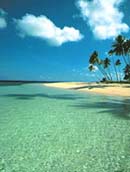 |
|
| Wild Indonesia |
 |
|
|
|

Indonesia is a land of creatures lost in time. Castaways from two continents settled the island chain of Indonesia, the greatest archipelago on Earth. Marooned on this scatter of islands, their descendants were out off from the outside world. Many became unique. Today, these thousands of islands have a wider diversity of life than anywhere else on the planet.
Fifty million years ago, sea stretched unbroken from Asia to Australia. But keep below the waves, huge pieces of the earth's crust were on the move. Where these giant fragments collided, molten lava spewed from the seabed. New land was born.
Over millions of years, what was once open ocean became an archipelago of more than seventeen thousand islands. Today, these islands form a line of stepping stones, running five thousand kilometers along the equator, from Northern Australia to Asia.
 A new island appeared as recently as 1928. That eruption was just one chapter in a long story of Krakatau. In 1883, one of the greatest explosions the earth has ever known ripped Krakatau apart. But just forty-five years later, a new island burst from the sea―the child of Krakatau. A new island appeared as recently as 1928. That eruption was just one chapter in a long story of Krakatau. In 1883, one of the greatest explosions the earth has ever known ripped Krakatau apart. But just forty-five years later, a new island burst from the sea―the child of Krakatau.
Within a year of its birth, Krakatau's child received its first colonists. Plants came, their seeds carried by wind and waves. Volcanic ash is a fertile seedbed. Animals arrived too...spiders on the wind, birds and bats on the wing.
This is a story that has been repeated all over Indonesia. When the volcanoes sleep, the colonists flood in. Rich volcanic soil attracted another kind of immigrant―people.
Fertile ash, ample rainfall and tropical sun make volcanic slopes like these the breadbasket of Indonesia. People have been farming here for countless generations. Terraces in Java date back two thousand years.
 The mountain gives, but it can also destroy. Living in the shadow of the volcano is dicing with death. Reminders of the fire beneath the surface are never far away. These are soils so rich that they yield three crops in a year. The mountain gives, but it can also destroy. Living in the shadow of the volcano is dicing with death. Reminders of the fire beneath the surface are never far away. These are soils so rich that they yield three crops in a year.
Java's terraces have been feeding people for twenty centuries, and feeding them well enough to support elaborate civilizations. The ruins of Borobudur date from the 8th century. Only a society that knew where its next meal was coming from could have afforded such a flowering of art and craftsmanship.
|
|
| Editor: Zhao Xuan CCTV.com |
|
|
|
|
|
 |



